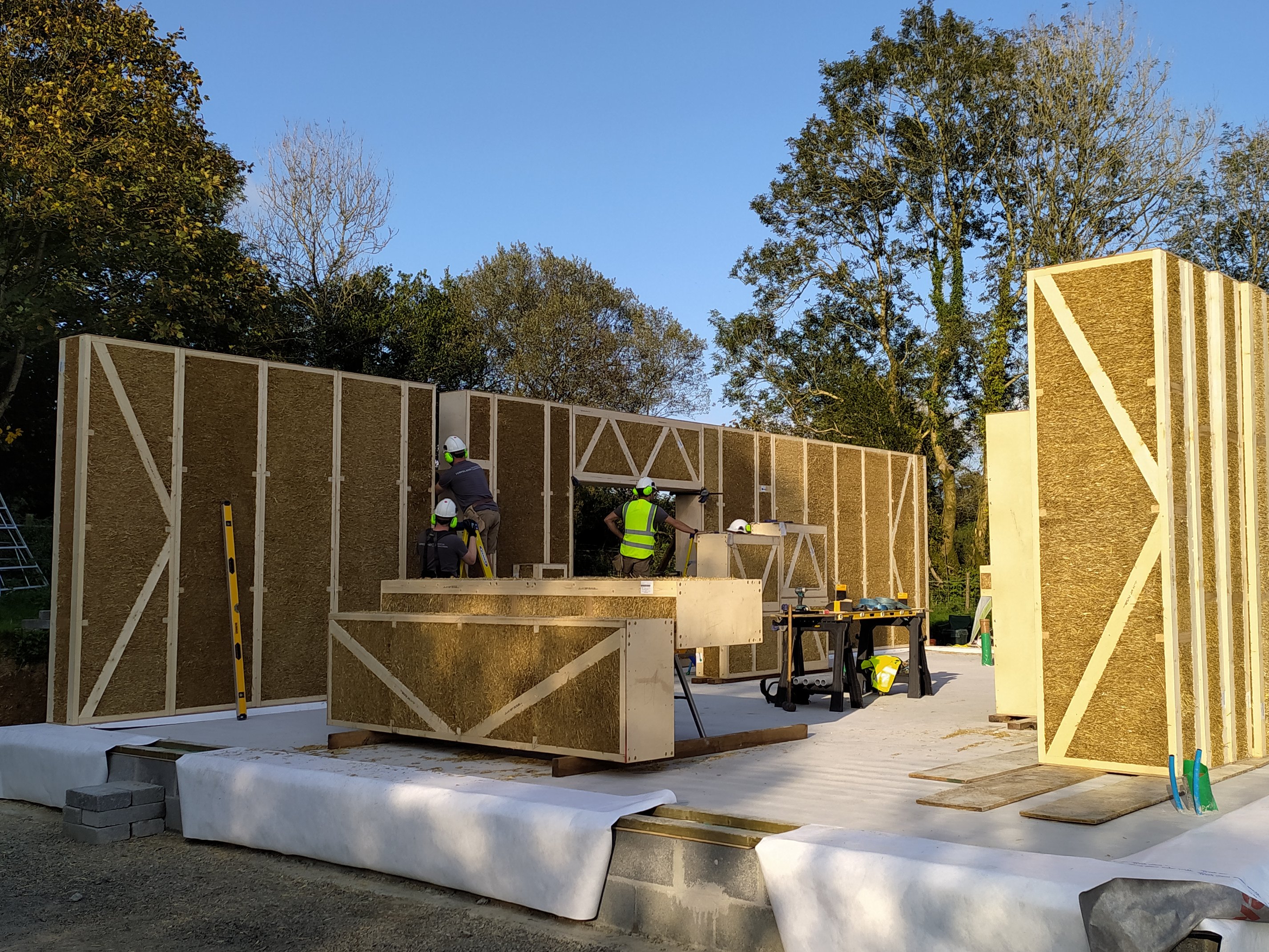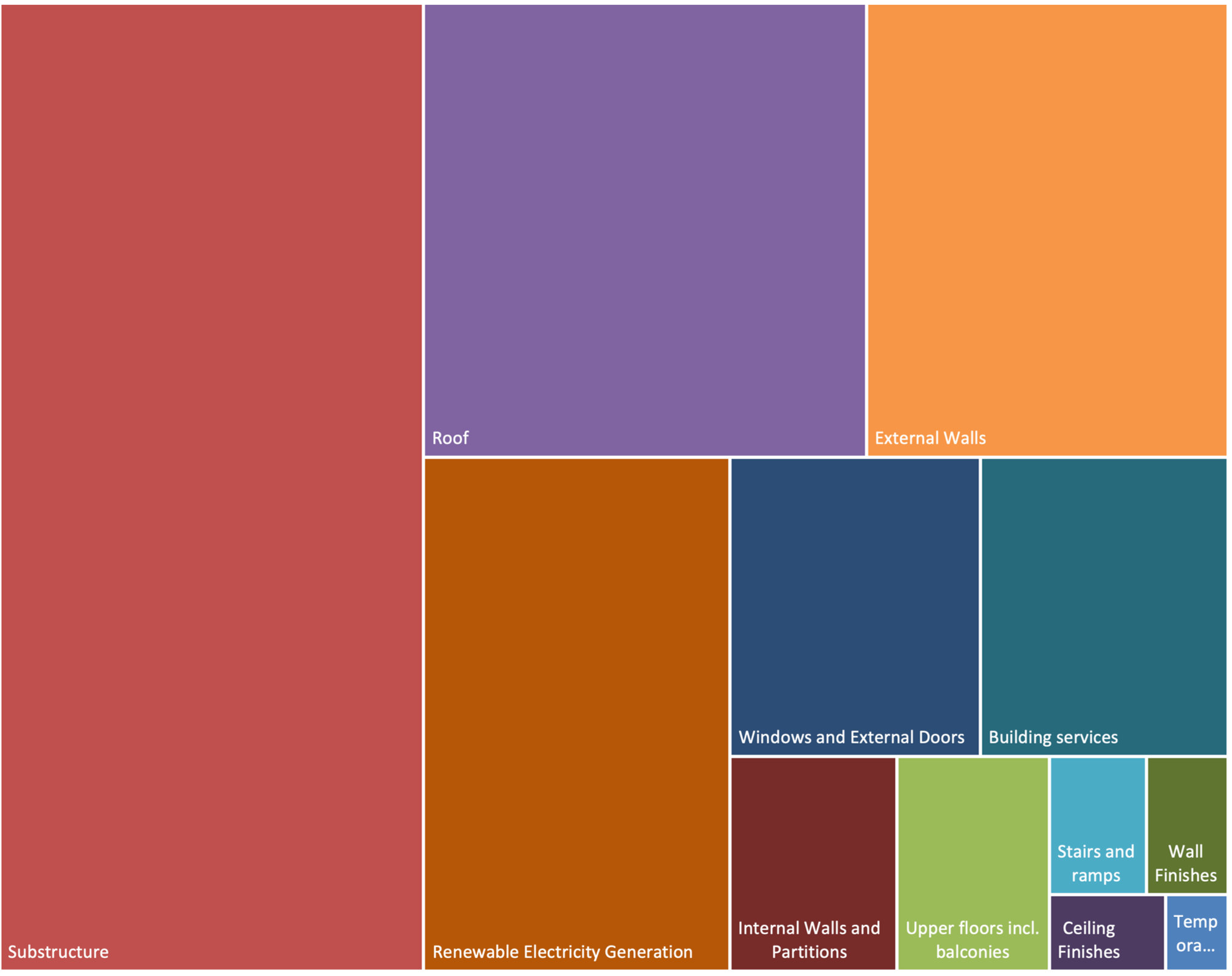Parc y Rhodyn
| Location: Wales | |
| Completion Status: Completed, 2022 | Occupancy: Occupied, 2022 |
| Architect: Michal Rudnicki (Stages 1-3), Huff & Puff Construction (Stages 4-6) | Consultant: Jonathan Davies, Juraj Micurcik |
| Contractor: EcoCocon, Hawkland Ecological Construction, The Passive House Builder | Client: Private clients |
| Certification: Passivhaus, 2022 | Certifier: Zero Energy + Passivhaus |
| Share this project: | |
 One Planet Passivhaus is a simple straw insulated SIPS self-build that prides itself on being off-grid. Shortlisted for the 2023 UK Passivhaus Awards in the new build residential category.
One Planet Passivhaus is a simple straw insulated SIPS self-build that prides itself on being off-grid. Shortlisted for the 2023 UK Passivhaus Awards in the new build residential category.
The Parc y Rhodyn straw insulated selfbuild in Wales is the UK's first certified Passivhaus that also meets One Planet Development & is entirely off-grid. The ambitious clients' brief asked for a low impact home built predominantly from bio-based materials with low running costs and minimal energy demand to meet their off grid aspirations.
One Planet Developments were introduced into planning policy by the Welsh government in 2011 as part of its One Wales: One Planet scheme and are measured through their Ecological Footprint.
By adopting the Passivhaus Standard, the clients could demonstrate a substantial reduction in the operational energy of the dwelling: achieving the standard using predominantly biogenic materials reduced embodied energy and introduced carbon sequestration. Minimising fuel consumption and consequently carbon emissions positively influenced the carbon analysis and ecological footprint.
Key stats
|
 |
The design philosophy for the house is rooted in the One Planet ethos, embracing Passivhaus principles to reduce the energy demand of the dwelling. Building form was critical as the envelope had to be compact to reduce the form factor and the material resource use of the project, while containing all the necessary home and work spaces. A central ‘core’ of kitchen and communal family living spaces occupies the central volume, with individual rooms accessed directly from this main area.
.jpg)
The project is not connected to any mains supplies of power, water or waste. Electricity is supplied by solar photovolatic (PV) on site while the minimal space heating required by the Passivhaus is provided by a wood burning cooker, which also heats the hot water. The solar PVs are split between a building-mounted and ground array that supply power to the house and feed battery storage in an external store. The arrays and storage have been sized to ensure adequate electricity is available to run the MVHR system even in the depths of winter. The wood burning stove sits in the middle of the floor plan to maximise the internal gains from its radiant heat. Fuel for the wood burner is largely supplied from on-site coppicing. The house is also self-sufficient with its water demands and naturally filtrate wastewater with reed beds.
Construction

Natural materials were used in construction, as far as possible. EcoCocon straw wall timber panels were the main construction system, with the roof insulated with recycled cellulose. The building is clay plastered internally to assist with moisture management and externally wrapped in Pavatherm woodfibre insulation with a ventilated rainscreen comprising locally sourced larch cladding.
The prefabricated EcoCocon SIPs is a Passivhaus Certified MMC system offering a thermal bridge free construction system. It was coupled with an additional layer of external woodfibre sheathing to further improve thermal performance. Detailing of the EcoCocon system has been well documented to satisfy the requirements of Passivhaus certification and all window and wall roof junctions closely followed the recommended principles.
Hoever, the floor wall junction required a more bespoke solution to respond to the heavy clay ground conditions, while also minimising embodied carbon, and involved encapsulating the inner leaf of the cavity masonry perimeter wall between the cavity fill and sub-slab foamed glass insulation.
 |
 |
 |
Overall U-values
|
Floor: 0.28 W/m2K Concrete slab on compacted geocell foamglas insulation. |
|
|
Wall: 0.12 W/m2K EcoCocon timber framed straw SIP with clay plaster finish internally, externally sheathed with woodfibre insulation & vertical Welsh larch cladding. |
|
|
Roof: 0.1 W/m2K Timber structure with blown cellulose insulation, externally clad in corrugated metal. |
Embodied Carbon

Building performance
|
Airtightness (≤ 0.6 ACH @ 50 Pa)
|
0.4 @ 50 Pa
|
|
Space Heating Demand (≤ 15 kWh/m².a)
|
15 kWh/m².a
|
|
Heating Load (≤ 10 W/m²)
|
11 W/m²
|
|
Primary Energy Demand (≤ 120 kWh/m².a)
|
60 kWh/m².a
|
|
Primary Energy Renewable Generation |
27 kWh/m².a
|
Ventilation & summer comfort strategy
Parc y Rhodyn has been developed to ensure summer comfort and maximise winter gains. Latent climate resilience is designed into the building, which achieves a target of 0% overheating without additional night ventilation.
- A total glazed area of 32.8m² (18.1% of TFA) is spread across the facades to provide adequate daylighting with 13.8m² in the south elevation.
- The majority of the glazing has operable units that can be opened to assist with additional night purge ventilation.
- Shading for windows in the south, east and west elevations has been carefully considered and extends beyond the 185mm deep window reveals.
- A veranda wraps around these aspects at ground floor 3.135m to the east and west, narrowing to 1.60m to the south to reflect the higher altitude of the sun to occlude the majority of incident solar radiation above an altitude of 45 °.
- First floor eaves extend 575mm beyond the building envelope to shade the upper portion of the first floor glazing units.
- The MVHR system is designed to locate supply and exhaust terminals on the sheltered north elevation of the house.
- During the summer the higher ambient temperatures trigger the MVHR's summer bypass mode and the ventilation temporarily suspends heat recovery, instead simply delivering fresh cool air into the internal spaces.
- In future climate scenarios, opening the windows for additional purge ventilation should adequately cool the building overnight.
.jpg)
Challenges
Meeting One Planet Development requirements brought many unusual challenges to the build. All the materials had to be sustainable, therefore natural materials (cellulose, straw and timber) with biogenic sequestration were prioritised. For building elements in contact with the ground, recycled materials such as foamed glass were used. Qualitative consideration of the carbon intensity of delivering the project drove many construction decisions, therefore wherever possible biogenic materials were specified and whenever possible they were sourced locally. For example, the external larch cladding was grown within 10 miles of the site and milled within the same radius.

Lessons learned
- Embracing Modern Methods of Construction (MMC) with a Passivhaus certified straw insulated SIP system accelerated the build process and delivered a watertight shell in just 12 weeks. Although the EcoCocon panels travelled from Lithuania, the speed of construction afforded by this prefabricated system resulted in lower carbon emissions than would be expected from a conventional stick build with contractors travelling to and from site daily for lengthy periods..
- Consideration needs to be given ahead of time to the importance of protecting the natural materials during the build process.
- For future projects, the team would want to develop a simplification of the thermal bridge mitigation in the floor wall detail.
Key team
|
 |
 |
 |
 |
Further information
Passivhaus: the route to zero carbon?
 Back to 2023 UK Passivhaus Awards
Back to 2023 UK Passivhaus Awards
#PHTawards2023




.jpg)
